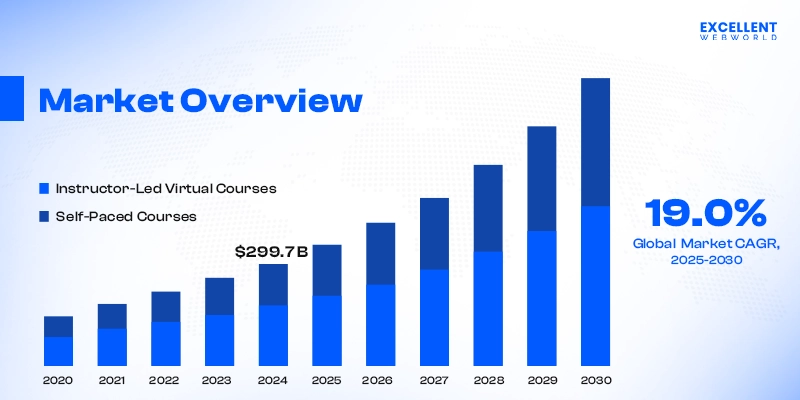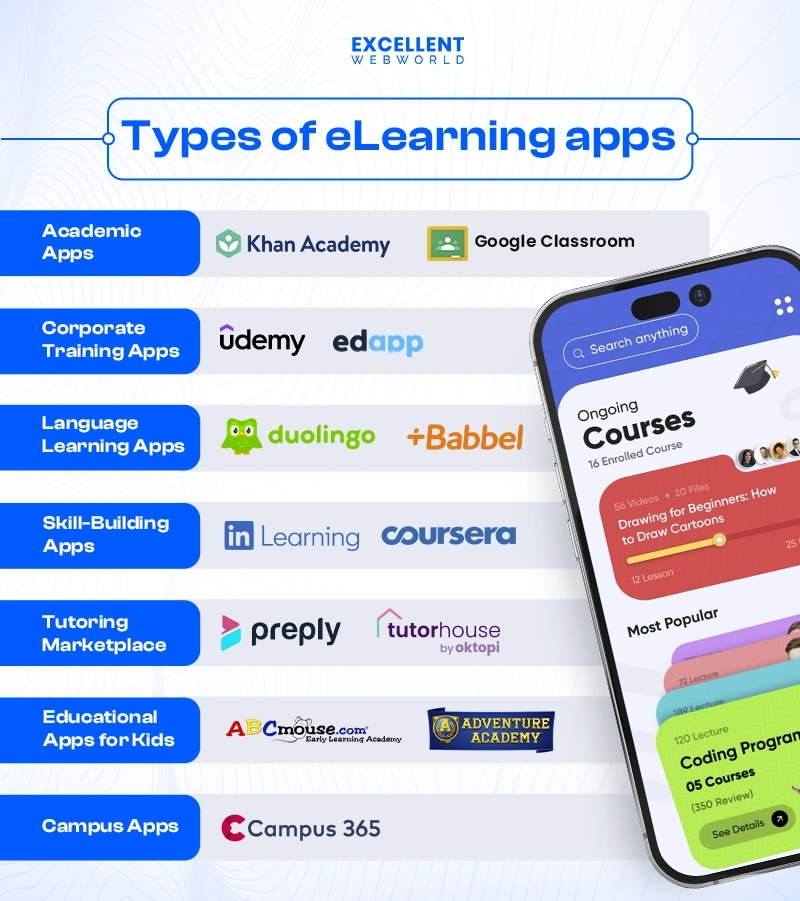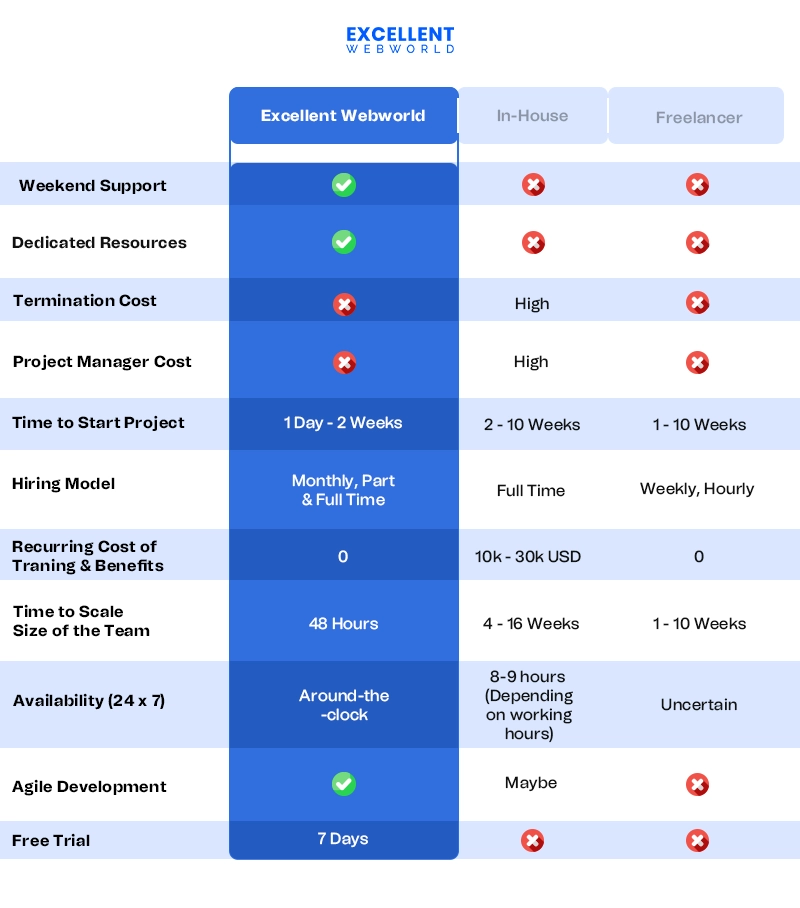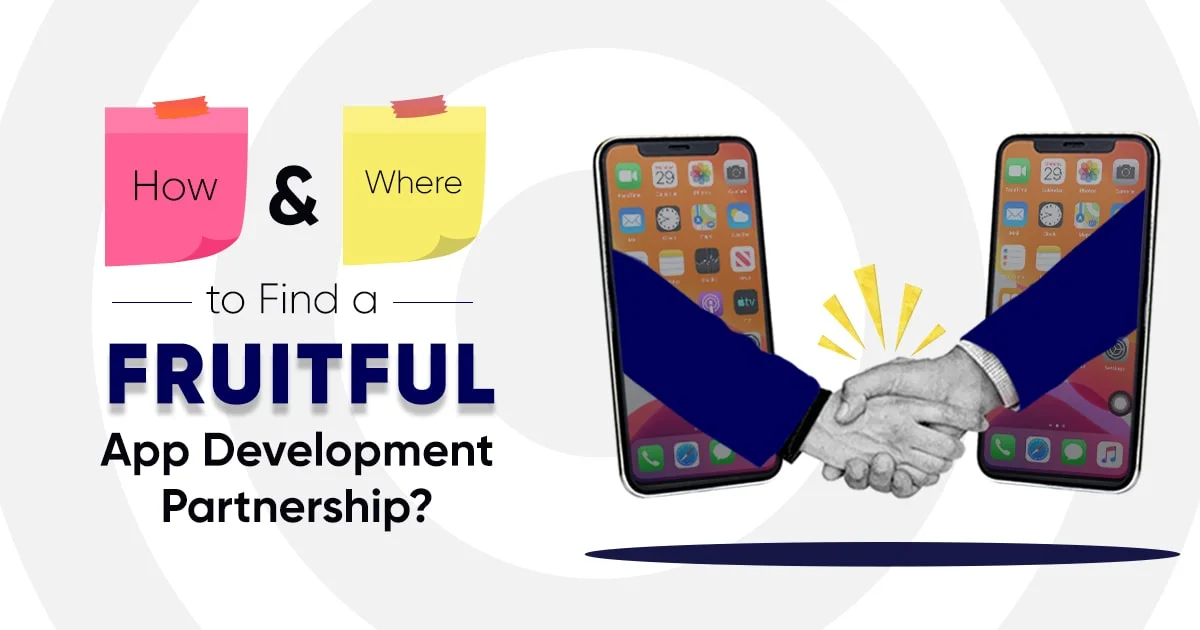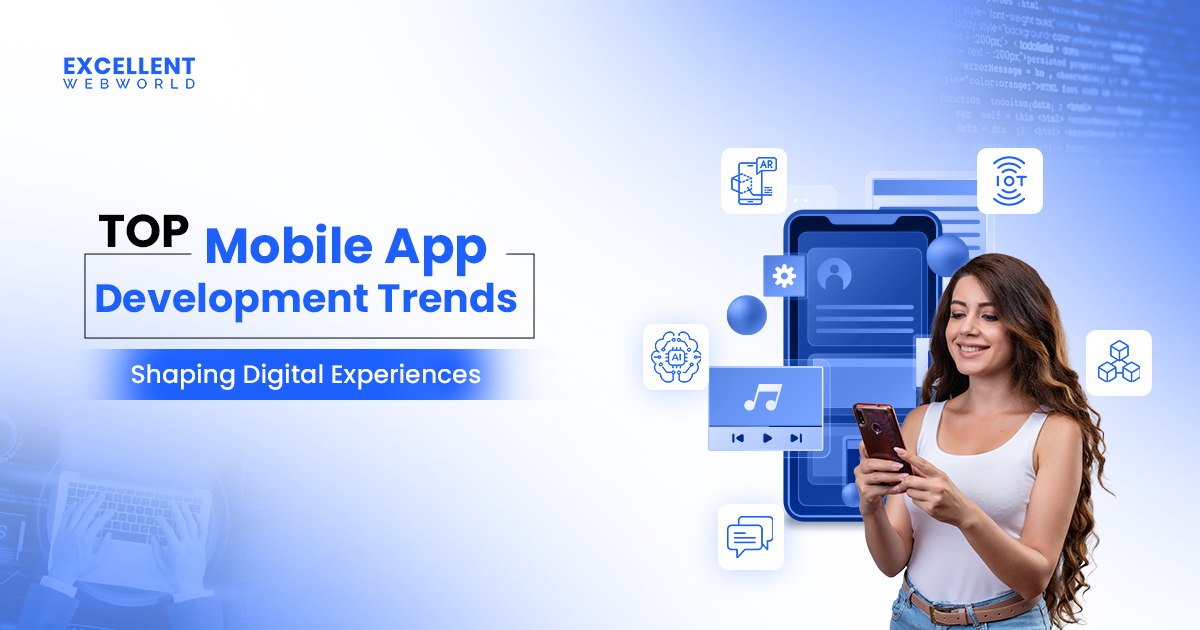Learners often feel disconnected from school and the skills required in the workplace. Apps like Preply, TutorMe, Lessonface, and Skooli have changed this situation. Online learning has also become the standard alternative option for professionals.
As a result, the spike in the demand for eLearning app development has created new opportunities for investors and innovators worldwide. If you want to bank on this demand but don’t know where to start, you’re at the right place.
Over the years, our team at Excellent Webworld has successfully designed, developed, and launched several eLearning apps for our clients. We are well-versed in what ticks and what doesn’t with end users, and this experience and knowledge have helped us create this step-by-step guide to cover every aspect of “how to develop an app for online education.”
You’ll find all the following things in the blog:
So, let’s jump in. But before that, let’s start with the basics first.
E-learning Market Overview: Is It Worth Your Attention?
Before we talk about the market of eLearning apps, there’s one thing we’d like to bring your attention to before you proceed.
We have noticed that when people inquire about “how to create an educational app” or “what’s the opportunity in educational app development,” they often mean they’re interested in developing an “eLearning app.” This is because the terms are frequently used interchangeably. However, you need to know that there is a subtle difference between the two.
Educational apps are generally designed to support a wide range of learning activities and can include games, interactive lessons, and problem-solving activities aimed at enhancing specific skills or knowledge areas. On the other hand, eLearning apps are more structured and are typically used to deliver courses or training modules online, often tracking progress and providing certifications. While both types aim to facilitate learning through technology, their approaches and functionalities can differ significantly.
Now, moving on to discussing the market of specifically “eLearning apps,” the global eLearning industry is booming and expected to reach USD 1 trillion by 2032. The corporate eLearning market alone is projected to grow to USD 44.6 billion by 2028. The European eLearning market is also expected to jump USD 147.7 billion between 2021 and 2025. Meanwhile, 75% of students in the United States prefer online classes. On the corporate side, 90% of companies now offer their employees some form of digital learning, highlighting the importance of eLearning in professional development.
So, to answer your original question. Yes, investing in an “eLearning app development” is definitely worth your attention. Otherwise, you’ll be missing out on capitalizing on a huge trend.
What is eLearning App Development?
eLearning app development can be defined as a process of creating mobile or web apps that deliver educational content and learning experiences. These apps are built to enhance the user experience of students, working professionals, or businesses. Moreover, these apps provide various educational materials, allowing one to learn new skills conveniently.
The development process involves market research, design, and building features. It allows seamless interaction with multimedia content, assessments, collaboration tools, and sometimes gamification. All are aimed at making learning more accessible and engaging.
If you’re a startup in EdTech industry with a limited budget, you also need to consider the “cost factor” to get an understanding of how much it’ll cost you to make an app in 2025 so you’re prepared in advance.
When we’re talking about the types of eLearning apps in the market, there are various and they all serve different purpose. Let’s take a look at them. It will help you to target users for your business.
Types of Mobile eLearning Apps and Their Purposes
Various types of mobile learning apps are tailored to different audiences, purposes, and features. You can find academic apps for schools and universities and corporate and commercial apps. eLearning apps are primarily accessible on both web and mobile platforms, while some are specifically designed for mobile users only.
For instance, at Excellent Webworld, we developed an innovative educational platform tailored for the African market that connects students, parents, teachers, and schools. The platform allows users to search for educational institutions, connect with educators, and access various online learning resources. Additionally, it provides a marketplace for educational services, including tuition sessions and job postings for teachers. Our solution has significantly enhanced the educational experience for all users involved, making the platform a key tool for measuring ROI in educational technology investments.
Let’s explore some common types of e-learning applications to inspire your business.
Must-Have Features for Mobile Learning Platforms
When planning the key features for your eLearning mobile app development, it’s essential to focus on what makes these platforms effective, engaging, and easy to use.
Keep in mind that the specific features you choose will depend on your business goals, target audience, and the type of app you want to create.
Here are some essential features we recommend including when developing eLearning apps for our clients:
1. Personal Account for Students and Teachers
One essential feature is the ability to sign up for your e-learning app. The user should be able to provide personal information, add credit cards, etc.
Choose different interfaces for learners and teachers, as your chosen features will depend on your users’ needs.
Here are some essential checklists you should consider:
2. Course System
The course feature manages the entire learning process. Typically, it delivers virtual learning materials through interactive courses in virtual classrooms.
These virtual classrooms are integrated into a mobile learning environment. The classroom system makes it easy to create and manage learning materials.
The course feature makes it easier for teachers to create more suitable learning material. This feature is convenient for teachers when choosing an application to use!
Here are some essential checklists you should consider:
3. Online Testing System
The app should help users take tests while including features to prevent cheating. For example, If you build an app like Duolingo, you can prevent users from leaving the app during a test or impose a time limit for test completion. These steps help create a fair testing atmosphere.
Here are some essential checklists you should consider:
4. Chat, Online Class, and Live Calls
Live calls and chat features are essential for better and faster communication. These video calls must have a solid technical foundation and be accessible, straightforward, and easy to use. In eLearning app development, focusing on reliable communication features can significantly enhance the learning experience.
Here are some essential checklists you should consider:
5. Certification System
Another essential feature for your eLearning app development is the ability to issue certifications that show a learner has completed a course. This system should be secure, ensuring users can only receive a certificate after passing a test. This way, you can confirm that they have truly mastered the material.
Here are some essential checklists you should consider:
6. Rating and Evaluation System
When developing an eLearning app, the evaluation system must be prioritized. Educators must set transparent standards for acceptance, passing, and grading. Adding a deadline can help students stay on track!
Here are some critical checklists you should consider:
7. Reminder and Notification System
Deadlines in the learning process are critical and crucial, but they are hard to track. For example, personalized reminders provide upcoming deadlines, due dates for payment, and tests that users need to complete. With this, you can help learners to stay organized and on top of their responsibilities.
Here are some crucial checklists you should consider:
8. AI Assistant
AI integration in eLearning app development will help learners with personalizations like habits, pace, and performance. AI assistants also recommend courses and resolve learner’s queries.
AI assistants trained through ML algorithms adapt to each learner’s requirements. This helps learners address their weaknesses and indicates where they can improve. Thus, the AI assistant feature can enhance your eLearning app business by providing personalization.
Here are some essential checklists you should consider:
9. Payments Gateways
Secure payments must be among your priorities. Integrate reliable payment gateways like PayPal, Apple Pay, or Google Pay to ensure that transactions are convenient and safe. This will help build trust with your users and make their payment experience smooth and secure.
Here are some essential checklists you should consider:
10. Gamification
Learning through games always seeks excitement and engagement. Your eLearning app must have gamification-based learning features, especially for kids.
Gamification in eLearning app development provides a gaming environment for the learning process, which increases engagement. Features like badges, leaderboards, and rewards make the process more interactive.
Here are some essential checklists you should consider:
11. Offline Learning
The offline mode is the need of the hour for educational apps to keep students engaged with the app. In internet spectrum problems, the offline mode acts as a saver.
Here are some essential checklists you should consider:
12. Virtual Classroom
Using augmented reality and virtual reality technologies provides a hypnotic learning experience. Virtual classroom features make your app more dynamic with the interactive learning environment.
Virtual classroom features create live sessions with instructors and discussions and collaborations on projects. This feature helps in honest time feedback with all comfort.
The concept of virtual classrooms is evolving in the eLearning app development industry. Virtual Classroom features are in very high demand and are setting a trend for the future of the eLearning landscape.
Technologies for eLearning App Development
Building an eLearning app requires a robust tech stack to ensure a seamless, scalable, and interactive learning experience. Here’s an overview of the technologies commonly used:
Electron.js for Desktop Apps
Electron.js is a robust framework that allows developers to build fully functional desktop apps using HTML, CSS, and JavaScript. It will enable you to create apps that work on Windows, MacOS, and Linux without separate codes.
React.js for Web Apps
React.js is a library that provides tools for creating complex UIs. It helps develop fast, efficient web apps that improve user experience.
React Native for Mobile Apps
You can develop a hybrid app for iOS and Android using a single codebase. This approach allows your developers to write the code once, which reduces the React native app development cost by up to 30%.
These frameworks make creating versatile applications across different platforms easier while keeping development efficient.
How to Develop an eLearning App?
If you are planning an online learning app development, here is a step-by-step guide.
1. Market Research
Thorough market research is essential for creating a successful eLearning app. It is the first step in understanding your target audience, competitors, and the latest trends.
This information will help you shape your app’s features, design, and content to meet user needs.
When done correctly, market research saves you time and money by preventing you from developing features that don’t align with user expectations.
2. Core Features
You already know your target users and what they need and expect from a learning app. Now is the perfect time to identify the must-have features that will make your app user-friendly and engaging. You should prioritize essential elements like personalized learning paths, progress tracking, and multimedia content such as videos, quizzes, and podcasts.
It’s essential to strike a balance between including necessary features and avoiding overwhelming learners. Focus on a few key functionalities that will make your app stand out.
A clear set of core features helps keep the development process on track and ensures your app isn’t too complicated or too essential for users.
3. Monetization Model
When planning how your eLearning app will make money, consider options like subscription plans, free models, and purchases.
Consider options according to the users, what they can afford, and what is valuable for them. Multiple pricing levels can help you reach more people while offering premium content and features to increase your earnings.
Your strategy should match your long-term goals, balancing profit-making and keeping your app accessible for sustainable growth.
4. MVP Development
Creating a Minimum Viable Product (MVP) in eLearning app development means launching an app with basic and essential features. It allows you to test the idea with users, get early feedback, and shape future updates.
Your MVP should focus on core functionality while leaving space for improvements based on how users interact.
Leveraging MVP development services helps reduce risks, speed up the launch process, and ensure it solves the user requirements.
5. Testing & Deployment
Deploy the MVP across platforms and collect feedback to evaluate your product. Analyzing learners’ feedback will highlight usage problems and determine whether you must address functionality concerns.
Some of the popular methods of gathering feedback are:
You should create a tight feedback loop to learn:
Once you analyze the feedback, integrate it with each iteration. Create and test multiple iterations before you launch the final product.
6. App Maintenance
Once your online learning app is launched, keeping it stable is crucial. You should frequently update the app to fix the bugs, improve security, and adapt to new operating system versions. Resolve user issues quickly and allow you to add new features based on trends and user feedback.
You should consider elements like updates on live courses, new skill sets or tutorials, and personalized doubt-solving sessions through AI integration, or you can hire a team for mobile maintenance services.
This approach keeps your app running smoothly, securely, and visually appealing, which is vital for its long-term success.
How eLearning Apps Make Money: Business & Revenue Models Uncovered.
Building a profitable eLearning app involves multiple revenue streams. These streams depend on your target audience and the quality of content.
Here are some popular ways you can generate revenue and grow your app:
1. Course Model
This model uses a pay-per-course approach with one-time or installment options. Platforms offer specialized courses with certifications, and the price is based on perfection and market demands.
2. Subscription Model
A subscription model is one of the most popular ways for eLearning platforms to earn money. In this model, users pay a monthly or yearly fee to access the platform’s courses and materials.
This approach provides consistent income and allows you to create different access levels or content to meet various needs and budgets. You can offer multiple basic, premium, and professional tiers to serve other users and maximize your revenue. One of the best examples of this model is LinkedIn Learning.
3. Freemium Model
The freemium allows users to access essential content and features for free, while premium content requires payment.
This model targets many users and converts some into paying customers, especially if the premium content offers more value. It gives users a taste of what you offer and encourages them to upgrade for more advanced features.
4. Certification Fees
In this model, you can offer certifications or badges that showcase user skills on their resumes or LinkedIn profiles. This can be a great feature. You can charge a fee for certification exams or for issuing certificates.
This approach increases revenue for your platform, boosts user engagement, and creates success stories, driving further growth in your online learning app development efforts.
5. Corporate Training Model
This model works for the apps that offer customized training solutions to businesses. Organizations pay for access to courses or a learning platform to train their employees.
This is a significant source of income for platforms like LinkedIn Learning.
6. Ads-Based Model
In this model, you can use ad-sense to generate revenue on your platform. Users can access educational information without paying, while the platform earns by showing advertisements.
Ads can be placed in various forms, such as banner ads, video ads, or interactive ads. This model provides accessibility to everyone and generates revenue through advertising.
Trends to be Aware of in eLearning App Development
New trends are covering the Edtech industry as it is growing continuously. These trends are making the marketplace more competitive for businesses, and you need to know these trends to shape your eLearning business.
1. Artificial Intelligence and Machine Learning
AI and ML are highly demanded and integrated into every industry, including eLearning. They help provide personalized learning experiences.
AI in education analyzes user data and creates personalized roadmaps according to the individual learning paces.
Additionally, these technologies automate educators’ administrative tasks, such as grading and feedback, ensuring their focus on teaching.
2. Virtual Reality (VR) and Augmented Reality (AR)
AR and VR are very revolutionary technologies that have already been used in eLearning app development. These technologies provide quality experiences to the users.
Leveraging VR development services, you can offer interactive surroundings that make learning easier. Plus, AR development services can help you infuse learning exercises with more engagement. As a result, learners grasp complex concepts quickly with interactive content.
3. Gamification
Games are the most enjoyable activity for children. Moreover, learning integrated with fun can be more helpful in driving engagement. A gamification learning platform provides a more engaging learning experience that promotes better knowledge retention.
4. Blockchain Technology
Blockchain technology ensures the security of an eLearning app by verifying credentials. This reduces fraud and offers a safe and transparent way to verify certifications and badges. Blockchain solutions enhance learners’ trust and recognition.
5. Microlearning and mobile-first design
One of the edtech industry’s top trends is delivering short and focused content. The eLearning app offers short content for mobile devices, making content more accessible for learners. Mobile-first design in eLearning app development ensures that short lessons can be completed on the go. It meets the modern learner’s demand according to their lifestyle.
6. Social Learning
Social learning trends offer discussion forums and interactive collaborations to improve learning. Incorporating social learning aspects into eLearning app development increases participation and creates more interactive environments.
The Cost of Custom eLearning App Development
Developing an eLearning app with essential features can cost between USD 18,000 and USD 50,000+, depending on factors such as the app’s complexity and features.
Creating an eLearning app is a detailed process that includes several essential steps, each with its costs. Understanding the cost of developing an eLearning app is crucial for its success. So, here is a comprehensive breakdown of eLearning app development costs based on different factors.
The Cost Breakdown According To The Platform
| Cost Category | iOS App Cost | Android App Cost |
|---|---|---|
| Basic app | USD 21,000 – 35,000+ | USD 18,000 – 30,000+ |
| Intermediate app | USD 35,000 – 45,000+ | USD 30,000 – 40,000+ |
| Complex app | USD 45,000+ | USD 40,000+ |
Cost Analysis According To The Complexity Of App
| Complexity | App Cost |
|---|---|
| Basic app | USD 18,000 – 35,000+ |
| Intermediate app | USD 35,000 – 45,000+ |
| Complex app | USD 45,000+ |
Cost Breakdown According To The Location Of The Team
| Cost Category | Basic app | Moderate app | Complex app |
|---|---|---|---|
| India | USD 18,000 – 35,000+ | USD 35,000 – 45,000+ | USD 45,000+ |
| UK | USD 30,000 – 70,000+ | USD 40,000 – 90,000+ | USD 60,000 – 120,000+ |
| USA | USD 40,000 – 80,000+ | USD 60,000 – 120,000+ | USD 80,000 – 200,000+ |
How Can Excellent Webworld Help You With eLearning App Development?
The above article should have helped you understand how to develop an eLearning app. However, one critical aspect of this process is understanding the nuances of the edtech industry. Excellent Webworld is an experienced eLearning app development company with domain expertise.
We have over 13 years of experience providing education app development services for education experts. Our team of experts has successfully developed high-performance educational apps that integrate advanced AI and AR/VR technologies. With more than 900 successful projects, our experts have catered to different client needs in the education industry.
We are a leading online learning app development company that offers end-to-end development and integration for AI practices. Contact us now to learn more about our solutions.
Why Choose Excellent Webworld’s Dedicated Team Over In-House Developers?
By choosing Excellent Webworld’s dedicated team, you can access a pool of skilled professionals without the overhead of hiring in-house staff or the irregularity of freelancer developers.
This dedicated team offers perfect expertise, reliability, and scalability, ensuring seamless collaboration and high-quality results.
FAQs
Research eLearning competitors, conduct market research, use website analytics, and gather user feedback. Additionally, creating buyer personas and brand strategies will help you to target your audience.
While developing your app, add quizzes and multimedia elements to make it more interactive. For short, on-the-go content, consider a mobile-first design.
There are various types of eLearning apps that you can choose by analyzing your target users.
Here are the types of eLearning apps:
The development timeline for educational software varies based on complexity, features, and other requirements. Building initial educational software with fundamental features can take 1-1.5 months. In contrast, more sophisticated software with advanced features like AI-based personalized learning or live streaming capabilities may require more than 6 months.
A robust tech stack ensures a seamless, scalable, interactive learning experience. HTML, CSS, and JS are commonly used technologies for desktop apps.
Additionally, react.js and react native for web and mobile apps.
The benefits of an educational app go beyond the usual learning experience. They include an enhanced learning experience, remote learning, centralized communication, and Personalized Learning Pathways.

Article By
Mahil Jasani began his career as a developer and progressed to become the COO of Excellent Webworld. He uses his technical experience to tackle any challenge that arises in any department, be it development, management, operations, or finance.

